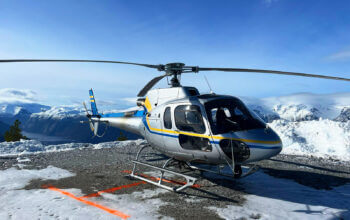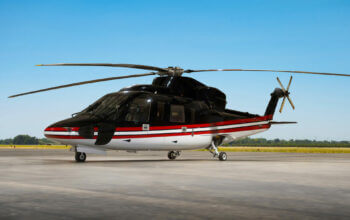Estimated reading time 13 minutes, 51 seconds.
When SaNaeah Allen was growing up in Fort Simpson, Northwest Territories (NWT), he’d lie on the bank of the Mackenzie River waiting for the tell-tale sound of his favorite plane: a de Havilland Beaver. The white aircraft with red-and-blue stripes would come flying low over the bank before landing on the river at Simpson Air’s float base.
“You hear the engine from a distance, like gloo, gloo, gloo,” he said. “It made a particular sound, and I was like, ‘Ah, it’s so cool! I want to fly that one day.’”
Now, Allen is well on his way to making that happen, having completed most of the program at the Terry Harrold School of Aviation in Fort Smith. A local airline, Northwestern Air Lease (NWAL), started the school in 2019, offering a homegrown solution to the ongoing pilot shortage across the country; Allen is the school’s first graduate.

When the school first opened, Jim Heidema, NWAL’s chief operating officer, said the carrier went to tradeshows and met with various levels of government and NGOs to try to get the word out as much as possible. NWAL touted the school’s unique training, which includes skis and floats, as well as an extreme weather survival component.
“That’s huge for us up north because that’s the reality of what we fly into,” said Heidema.
The Terry Harrold School of Aviation uses two Cessna 172 for flight training — one of the most popular training aircraft in the world. The Cessna 172N (standard equipment) is used for basic training and short local flights, while the modified Cessna 172M (equipped for instrument flight) is used for basic instrument rating training. A Cessna 206 is utilized for float and ski training.
The specialized training that comes with being a pilot in the North is precisely what makes such pilots so attractive to larger carriers elsewhere.
As with many other industries, the North is seen more as a training ground for recent graduates than a place to spend an entire career.
“I’m sure our existing pilots right now are being approached,” said Heidema. “They’re being approached as we speak.”
A stepping stone
For Noud Huis in’t Veld, it’s the aspiration of flying internationally that is one day going to pull him away from the North. Currently a first officer, he’s honest about his time with NWAL being a stepping stone towards larger carriers.
“A lot of people that go into aviation do it because they have a passion for flying,” he said. “It’s hard for the carriers up here to entice people to stay when passionate people are going to be constantly seeking the next thing to develop professionally.”
Huis in’t Veld became a pilot after going through a “quarter-life crisis.” He was well on his way towards a different career, but realized he couldn’t see himself in that position for the next 30 years. He completed his private and commercial licenses, as well as his multi-engine rating and IFR (instrument flight rules) training in 14 months during the pandemic.
While his partner was already working for NWAL, Huis in’t Veld said it was a no-brainer to leave British Columbia and join him in Fort Smith. He moved in the summer of 2021 for a pilot-in-waiting position, and it took five months before he upgraded to flying.
Fast forward a year, and Huis in’t Veld has seen numerous pilots move on from NWAL, including his partner. Combined with the larger shortage, he says those losses have a bigger impact on small carriers.

“If you lose two pilots, that might be 10 or 20 percent of your pilot pool that has now left; versus some of the major carriers, if they lose a handful of pilots, they can backfill that in some way,” he explained. “We don’t have that luxury up here.”
It’s hard to overstate the importance of aviation in the North. The NWT alone has about a dozen fly-in communities that rely on planes for everything from groceries and mail, to tourists and medical services.
Following the easing of pandemic restrictions across the country, demand for travel has skyrocketed. The pilot shortage has been talked about in the North for years, but the pandemic exacerbated the problem. NWAL is no exception. The airline currently has 11 pilots and, despite increased demand for travel, has cut the number of scheduled weekly flights from 29 to 10. Heidema says NWAL would need to double its pilot pool to operate at full capacity.
But vacationing is the least of northerners’ worries. With so many remote communities, air travel is a standard part of the medical system. Of course, medevac services are crucial, but routine medical procedures — like MRIs — require a flight to Edmonton.
“Our cancellations here have more profound impacts on the people we serve,” said Huis in’t Veld.
The territorial government says there have been some minor issues with coordinating scheduled flights, but the impact on non-emergency medical travel has been limited so far.
With the majority of pilots coming from southern Canada, Huis in’t Veld says one solution for northern carriers to retain those pilots could be rotations or condensed schedules. That way, pilots, mechanics, and other staff would have more time to return to their friends and family. Still, he expects to be at NWAL for another year or so, working towards his airline transport pilot license before making the jump to a larger carrier.
“I can build those hours here,” he said. “The pilot-in-command hours are a lot harder to get down south.”
Attracting northerners
Aurora College, the NWT’s main post-secondary institution, is looking to fight the pilot shortage as well. This September, it launched a new two-year aviation business program in partnership with the Terry Harrold School of Aviation. (This is separate from the program Allen went through.) Students that complete the college program will come out of it with a commercial pilot license and business diploma. Four students — three from the NWT and one from Nunavut — are currently enrolled.
Ultimately, Heidema says the goal is to build an aviation training ground second-to-none in Fort Smith that would include a simulation center.
“We want to blow up the aviation program,” he said, “so we get up to (about) 100 students every year. We want to do a huge influx of students, because we really want to combat this revolving door of pilots.”
One of the reasons the aviation school partnered with Aurora College is to make it easier for applicants to access financial assistance with the territorial government. It’s no secret flight school is expensive. Allen managed to pay for it through a combination of grants, scholarships, and even gift cards. During the pandemic, Łı́ı́dlı̨ı̨ Kų́ę́ First Nation handed out Northern Store gift cards to its members. Allen was living on his own, about 700 kilometers (435 miles) away, so his family mailed the gift cards to him to help with groceries.
That type of community support has helped Allen pursue flying. When he started, there were three other students; he’s the only one left.
“My family members all say that they’re very proud of me,” he shared, adding that he sometimes feels like a celebrity because even strangers are cheering him on.
It’s not often residents from the North’s small communities go on to become pilots. Allen recognizes the privilege that comes with the position; after getting his private license, his instructor told him he was now part of a select group of people that have the freedom of flight.
But Allen says there’s also a “mythology” that comes with being a pilot, which leads to people, especially youth, being intimidated to pursue aviation. He gets an edge of frustration in his voice as he explains how often he’s heard other youth say they would be too “stupid” to become a pilot.
“No, you’re not,” he said. “A lot of the kids, they act dumb, when in reality they’re pretty smart.”
He believes demystifying what it takes to become a pilot, as opposed to making it look “scary and intimidating,” would help encourage more northerners to pursue flying.
Allen says NWAL has hinted at him having a job with the carrier after passing his exams, but he still plans to return to Fort Simpson. To him, the North is much more than a stepping stone.

“Sometimes I’m asked if I’m gonna go work as an airline pilot, and I always tell them, ‘I don’t like to suit and tie,’” he said. “I understand that the job pays more, but at the same time, the North is my home.”
Plus, the opportunity to be a bush pilot and fly an iconic aircraft like the Beaver is too good to pass up.









A tremendous story. Wonderful to learn about the Terry Herrold School of Aviation and to see that it is already providing much needed talent for the aviation industry. Excellent supporting images as well.
Does the Terry Herrold School of Aviation have online courses? Can I get more information? Am I too old at 63?